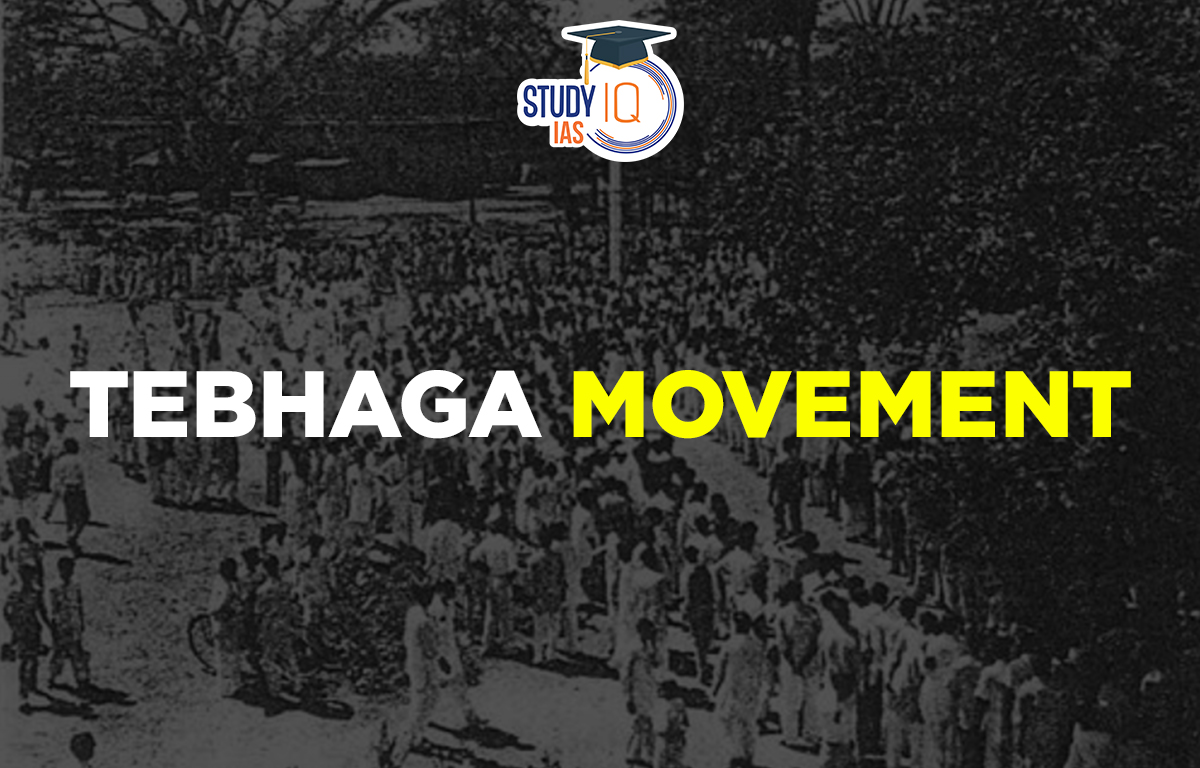Table of Contents
Tebhaga Movement
The Tebhaga Movement was the fiercest in Indian history. There was a bloody farmer uprising just before Bengal was divided and India became independent. Tebhaga means “three shares of the harvest” in its literal sense. The Tebhaga movement was a sharecroppers’ campaign. Tenants requested two-thirds of the harvest from the land, with the remaining one-third going to the landowners. Essentially, this fundamental demand is where the name “Tebhaga” campaign comes from. To prepare for the UPSC exam, the candidate will discover all the information related to the Tebhaga Movement.
Read More: Wahabi Movement
Tebhaga Movement History
According to the adhi, barga, or bhag system, a bargadar was a person who worked on another person’s land in return for that person giving up a share of the harvest. The size and quality of the lands the zamindars owned determined the amount of annual tax they were required to pay, which in turn determined their relationship with the British government.
They were beneath the class of jotedars, to whom the zamindars granted territories under the Pattani system. Agriculture and the lands had a direct bearing on the jotedars elite. Jotedars determined that the farmer and the jotedar, the landowner, would each receive an equal share of the overall output from the land. This technique of land cultivation was known as Adhiary Pratha, or the “half-half system,” and it was most common in north Bengal.
In the past, jotedars used cultivators’ labour for a variety of purposes, making the impoverished bargadar the landowner’s slave. He was frequently threatened by the jotedar with taking away the property and making the bargadar go without food if he did not comply. It was a restrictive structure. Peasants’ complaints grew in the immediate aftermath of a devastating famine in Bengal (1942) as the country’s economic position deteriorated. The poor economic circumstances, political unrest, and intolerable social conditions of the peasants served as the catalyst for the movement that would later become known as the Tebhaga Movement.
Read More: Faraizi Movement
Tebhaga Movement Objective
Two-thirds of the produce from the property was demanded by tenants, with the remaining third going to the landlords. Basically, the term “Tebhaga” movement derives from this fundamental demand. The Kisan Sabha launched a militant operation in Bengal in 1946–1947.
Sharecropping peasants were then required to give the landowners half of their produce. The Tebhaga movement called for the share granted to landlords to be cut to one-third. The Bargadari Act, which stipulated that the landlords’ share of the harvest would be limited to one-third of the total, was introduced by the province’s then-Muslim League ministry in reaction to the protests. However, the law was not completely applied.
Read More: Aligarh Movement
Tebhaga Movement Feature
- “Nij Kamare Dhan Tolo” was the movement’s primary slogan.
- Women actively participated in the movement on a wide scale.
- The landless and underprivileged peasant women organised into fighting units known as Nari Bahini and played a leading role in protecting the movement’s victories and resisting state repression.
Read More: Reform Movement in North India
Tebhaga Movement Reason
In 1946–1947, the Bengal region’s sharecroppers led the Tebhaga campaign against the tyrannical Jotedars. The Bengali sharecropping system, which was in use, was the cause of the revolt. In the Bengal region at the beginning of the nineteenth century, a new class of wealthy peasants known as jotedars arose. Large swaths of land were amassed by the jotedars in rural regions. Additionally, they had influence over local markets, lending operations, and poor farmers.
These jotedars held more power in rural villages than the Zamindars, who frequently resided in urban regions. Sharecroppers, also known as bhagadars, worked the vast agricultural lands under the jotedars’ control and gave them half of the produce as payment. The jotedars were primarily centred in North Bengal, while they are known as haoladars, gantidars, or mandals in other Bengali regions.
Read More: Tribal Movements in India
Tebhaga Movement Impact
The bhagadars contested the share cropping scheme that was in place by the end of 1946. They argued that they would only pay one-third of the product and that it should be stored in their godowns (also known as khamars), not those of jotedars, before the share of the produce was paid. The Floud Commission, which had already advocated for the sharecroppers’ proposal to the government, inspired them.
The All India Kisan Sabha, the CPI’s peasant wing, was in charge of the campaign. At first, only a few peasants took part, but in January 1947, the Sharecroppers’ Demand was integrated into the Bengal Bargadars Temporary Regulation Bill.
Read More: Kuka Movement
Tebhaga Movement UPSC
The Tebhaga uprising, which extended across sizable portions of the countryside and expressed the desire of working men and women to be freed from exploitation, was in many ways the turning point. At its height, the Tebhaga campaign drew 60 lakh participants. The campaign was started in response to an economic problem. This essay contains all the information you need to prepare for the UPSC Exam using the Tebhaga Movement.
Read More: Bhil Revolt


 Nagari Pracharini Sabha Revival: Backgro...
Nagari Pracharini Sabha Revival: Backgro...
 Ryotwari System in India, Features, Impa...
Ryotwari System in India, Features, Impa...
 Battle of Plassey, History, Causes, Impa...
Battle of Plassey, History, Causes, Impa...





















